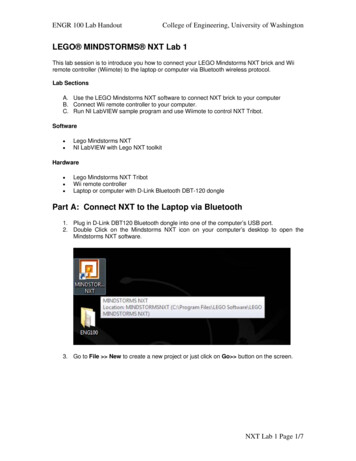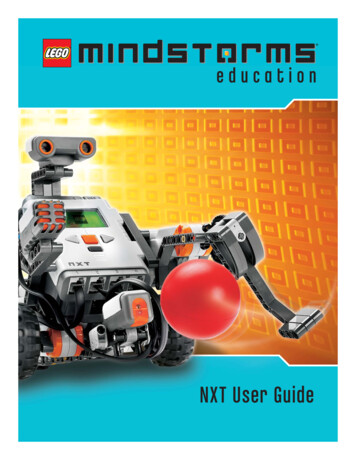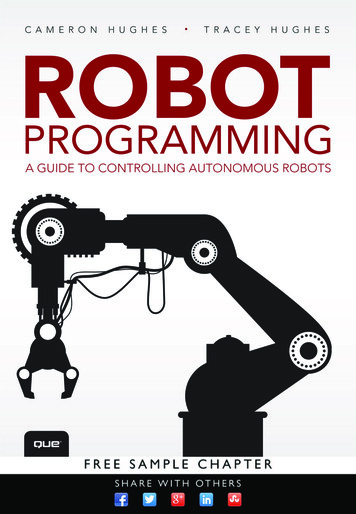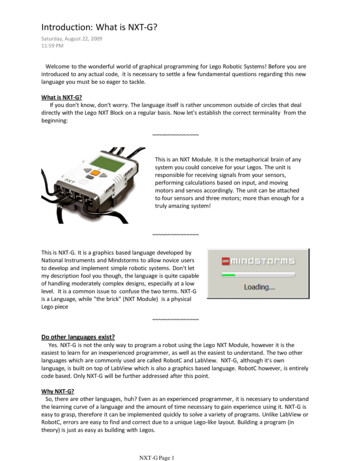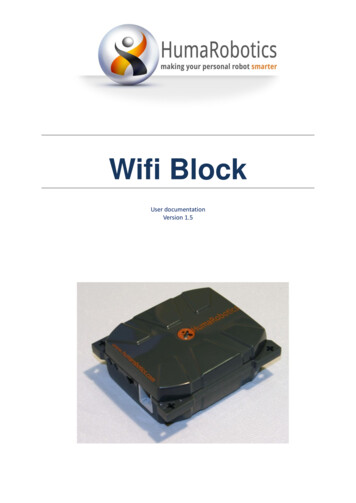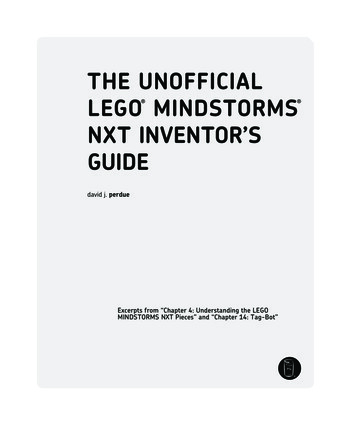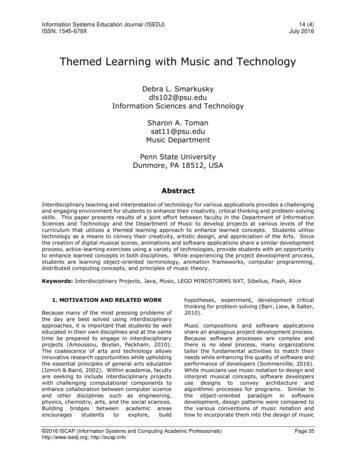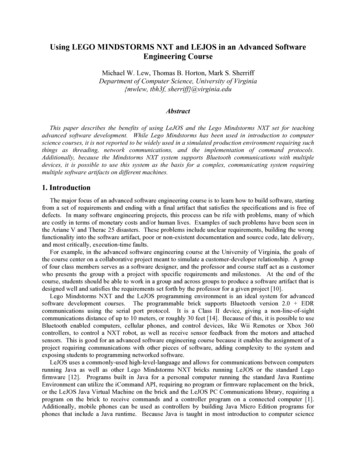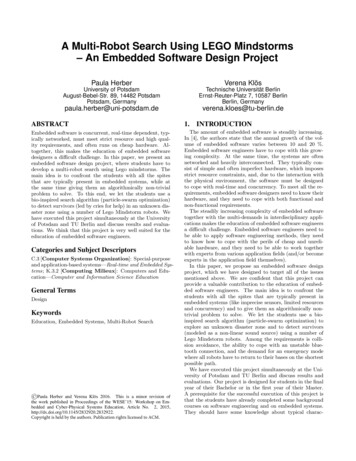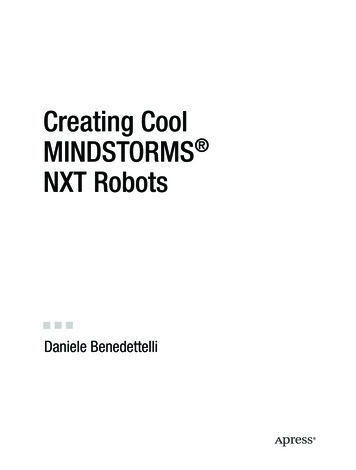
Transcription
Creating Cool MINDSTORMSNXT RobotsDaniele Benedettelli
Creating Cool MINDSTORMS NXT RobotsCopyright 2008 by Daniele BenedettelliAll rights reserved. No part of this work may be reproduced or transmitted in any form or by any means,electronic or mechanical, including photocopying, recording, or by any information storage or retrievalsystem, without the prior written permission of the copyright owner and the publisher.ISBN-13 (pbk): 978-1-59059-966-2ISBN-10 (pbk): 1-59059-966-7ISBN-13 (electronic): 978-1-4302-0599-9ISBN-10 (electronic): 1-4302-0599-7Printed and bound in the United States of America 9 8 7 6 5 4 3 2 1Trademarked names may appear in this book. Rather than use a trademark symbol with every occurrenceof a trademarked name, we use the names only in an editorial fashion and to the benefit of the trademarkowner, with no intention of infringement of the trademark.Lead Editor: Jeffrey PepperTechnical Reviewer: Claude BaumannDevelopmental Editor: John R. VaccaEditorial Board: Clay Andres, Steve Anglin, Ewan Buckingham, Tony Campbell, Gary Cornell,Jonathan Gennick, Matthew Moodie, Joseph Ottinger, Jeffrey Pepper, Frank Pohlmann, BenRenow-Clarke, Dominic Shakeshaft, Matt Wade, Tom WelshProject Manager: Beth ChristmasCopy Editor: Susannah Davidson PfalzerAssociate Production Director: Kari Brooks-CoponyProduction Editor: Kelly WinquistCompositor: Kinetic Publishing Services, LLCProofreader: April EddyIndexer: Becky HornyakArtists: April Milne, Dina QuanCover Designer: Kurt KramesManufacturing Director: Tom DebolskiDistributed to the book trade worldwide by Springer-Verlag New York, Inc., 233 Spring Street, 6th Floor,New York, NY 10013. Phone 1-800-SPRINGER, fax 201-348-4505, e-mail orders-ny@springer-sbm.com, orvisit http://www.springeronline.com.For information on translations, please contact Apress directly at 2855 Telegraph Avenue, Suite 600, Berkeley,CA 94705. Phone 510-549-5930, fax 510-549-5939, e-mail info@apress.com, or visit http://www.apress.com.Apress and friends of ED books may be purchased in bulk for academic, corporate, or promotional use.eBook versions and licenses are also available for most titles. For more information, reference our SpecialBulk Sales–eBook Licensing web page at http://www.apress.com/info/bulksales.The information in this book is distributed on an “as is” basis, without warranty. Although every precautionhas been taken in the preparation of this work, neither the author(s) nor Apress shall have any liability toany person or entity with respect to any loss or damage caused or alleged to be caused directly or indirectlyby the information contained in this work.The source code for this book is available to readers at http://www.apress.com. You will need to answerquestions pertaining to this book in order to successfully download the code.
To my brother Alessandro
Contents at a GlanceAbout the Author . . . . . . . . . . . . . . . . . . . . . . . . . . . . . . . . . . . . . . . . . . . . . . . . . . . . . . . . . . . . . . . . . . xiAbout the Technical Reviewer . . . . . . . . . . . . . . . . . . . . . . . . . . . . . . . . . . . . . . . . . . . . . . . . . . . . . . xiiiAcknowledgments . . . . . . . . . . . . . . . . . . . . . . . . . . . . . . . . . . . . . . . . . . . . . . . . . . . . . . . . . . . . . . . . xvIntroduction . . . . . . . . . . . . . . . . . . . . . . . . . . . . . . . . . . . . . . . . . . . . . . . . . . . . . . . . . . . . . . . . . . . . xxviiPART 1 Look, Mom! No Wheels! CHAPTER CHAPTER CHAPTER CHAPTER CHAPTER CHAPTER123456Building Biped Robots . . . . . . . . . . . . . . . . . . . . . . . . . . . . . . . . . . . . . . . . . . 3Quasimodo . . . . . . . . . . . . . . . . . . . . . . . . . . . . . . . . . . . . . . . . . . . . . . . . . . . . 11Finite State Machines . . . . . . . . . . . . . . . . . . . . . . . . . . . . . . . . . . . . . . . . . . 47NXT AT-ST . . . . . . . . . . . . . . . . . . . . . . . . . . . . . . . . . . . . . . . . . . . . . . . . . . . . . 59Omni-Biped . . . . . . . . . . . . . . . . . . . . . . . . . . . . . . . . . . . . . . . . . . . . . . . . . . 143NXT Turtle . . . . . . . . . . . . . . . . . . . . . . . . . . . . . . . . . . . . . . . . . . . . . . . . . . . . 203PART 2 Back on Wheels CHAPTER 7 CHAPTER 8 CHAPTER 9 APPENDIXMine Sweeper . . . . . . . . . . . . . . . . . . . . . . . . . . . . . . . . . . . . . . . . . . . . . . . . 281JohnNXT Is Alive! . . . . . . . . . . . . . . . . . . . . . . . . . . . . . . . . . . . . . . . . . . . . . 347Need Input! Building a Remote Control Device . . . . . . . . . . . . . . . . . 517Introduction to BricxCC and NXC Programming . . . . . . . . . . . . . . . . 567 INDEX . . . . . . . . . . . . . . . . . . . . . . . . . . . . . . . . . . . . . . . . . . . . . . . . . . . . . . . . . . . . . . . . . . . . . . . 579v
ContentsAbout the Author . . . . . . . . . . . . . . . . . . . . . . . . . . . . . . . . . . . . . . . . . . . . . . . . . . . . . . . . . . . . . . . . . . xiAbout the Technical Reviewer . . . . . . . . . . . . . . . . . . . . . . . . . . . . . . . . . . . . . . . . . . . . . . . . . . . . . . xiiiAcknowledgments . . . . . . . . . . . . . . . . . . . . . . . . . . . . . . . . . . . . . . . . . . . . . . . . . . . . . . . . . . . . . . . . xvIntroduction . . . . . . . . . . . . . . . . . . . . . . . . . . . . . . . . . . . . . . . . . . . . . . . . . . . . . . . . . . . . . . . . . . . . xxviiPART 1 Look, Mom! No Wheels! CHAPTER 1Building Biped Robots . . . . . . . . . . . . . . . . . . . . . . . . . . . . . . . . . . . . . . . 3LEGO Bipedal Walking: The State of the Art . . . . . . . . . . . . . . . . . . . . . . . . . . 3Interlacing Legs Bipeds . . . . . . . . . . . . . . . . . . . . . . . . . . . . . . . . . . . . . . . . . . . 3Jerky COG Shifting Bipeds . . . . . . . . . . . . . . . . . . . . . . . . . . . . . . . . . . . . . . . . . 5Smooth COG Shifting Bipeds . . . . . . . . . . . . . . . . . . . . . . . . . . . . . . . . . . . . . . . 9Summary . . . . . . . . . . . . . . . . . . . . . . . . . . . . . . . . . . . . . . . . . . . . . . . . . . . . . . 10 CHAPTER 2Quasimodo. . . . . . . . . . . . . . . . . . . . . . . . . . . . . . . . . . . . . . . . . . . . . . . . . . 11Applying What You Learned . . . . . . . . . . . . . . . . . . . . . . . . . . . . . . . . . . . . . . 12Introducing NXT Technology . . . . . . . . . . . . . . . . . . . . . . . . . . . . . . . . . . . . . . 15Meeting the NXT-G Software . . . . . . . . . . . . . . . . . . . . . . . . . . . . . . . . . . . . . . 17Connecting the NXT for the First Time . . . . . . . . . . . . . . . . . . . . . . . . . 17Programming Quasimodo Using NXT-G . . . . . . . . . . . . . . . . . . . . . . . . 20The Shortest Program in the Book . . . . . . . . . . . . . . . . . . . . . . . . . . . . . . . . . 22Building Your Belfry Hunchback . . . . . . . . . . . . . . . . . . . . . . . . . . . . . . . . . . . 25Summary . . . . . . . . . . . . . . . . . . . . . . . . . . . . . . . . . . . . . . . . . . . . . . . . . . . . . . 45 CHAPTER 3Finite State Machines . . . . . . . . . . . . . . . . . . . . . . . . . . . . . . . . . . . . . . . 47Finite State Machines in Brief . . . . . . . . . . . . . . . . . . . . . . . . . . . . . . . . . . . . . 47Saturating Counter . . . . . . . . . . . . . . . . . . . . . . . . . . . . . . . . . . . . . . . . . . . . . . 49FSM General Implementation . . . . . . . . . . . . . . . . . . . . . . . . . . . . . . . . . . . . . 55Decision Tables . . . . . . . . . . . . . . . . . . . . . . . . . . . . . . . . . . . . . . . . . . . . . . . . . 56Summary . . . . . . . . . . . . . . . . . . . . . . . . . . . . . . . . . . . . . . . . . . . . . . . . . . . . . . 58vii
viii CONTENTS CHAPTER 4NXT AT-ST . . . . . . . . . . . . . . . . . . . . . . . . . . . . . . . . . . . . . . . . . . . . . . . . . . . 59Design Thoughts . . . . . . . . . . . . . . . . . . . . . . . . . . . . . . . . . . . . . . . . . . . . . . . . 60Programming the AT-ST . . . . . . . . . . . . . . . . . . . . . . . . . . . . . . . . . . . . . . . . . . 62Building Your Personal AT-ST . . . . . . . . . . . . . . . . . . . . . . . . . . . . . . . . . . . . . 71Summary . . . . . . . . . . . . . . . . . . . . . . . . . . . . . . . . . . . . . . . . . . . . . . . . . . . . . 141 CHAPTER 5Omni-Biped . . . . . . . . . . . . . . . . . . . . . . . . . . . . . . . . . . . . . . . . . . . . . . . . . 143History of a Biped . . . . . . . . . . . . . . . . . . . . . . . . . . . . . . . . . . . . . . . . . . . . . . 144Single-Tasking vs. Multitasking . . . . . . . . . . . . . . . . . . . . . . . . . . . . . . . . . . 145Writing a Single-Task Program . . . . . . . . . . . . . . . . . . . . . . . . . . . . . . . . . . . 149Using Hysteresis . . . . . . . . . . . . . . . . . . . . . . . . . . . . . . . . . . . . . . . . . . . . . . . 154Writing a Multitask Program . . . . . . . . . . . . . . . . . . . . . . . . . . . . . . . . . . . . . 158Building Instructions . . . . . . . . . . . . . . . . . . . . . . . . . . . . . . . . . . . . . . . . . . . . 163Summary . . . . . . . . . . . . . . . . . . . . . . . . . . . . . . . . . . . . . . . . . . . . . . . . . . . . . 201 CHAPTER 6NXT Turtle. . . . . . . . . . . . . . . . . . . . . . . . . . . . . . . . . . . . . . . . . . . . . . . . . . 203Quadruped Walking . . . . . . . . . . . . . . . . . . . . . . . . . . . . . . . . . . . . . . . . . . . . 204Introducing the Turtle . . . . . . . . . . . . . . . . . . . . . . . . . . . . . . . . . . . . . . . . . . . 206Programming the Turtle . . . . . . . . . . . . . . . . . . . . . . . . . . . . . . . . . . . . . . . . . 207Simple Program . . . . . . . . . . . . . . . . . . . . . . . . . . . . . . . . . . . . . . . . . . . 207Line Following . . . . . . . . . . . . . . . . . . . . . . . . . . . . . . . . . . . . . . . . . . . . 214Autonomous Behavior Simulation . . . . . . . . . . . . . . . . . . . . . . . . . . . . 217Building Your Pet . . . . . . . . . . . . . . . . . . . . . . . . . . . . . . . . . . . . . . . . . . . . . . . 233Design Thoughts . . . . . . . . . . . . . . . . . . . . . . . . . . . . . . . . . . . . . . . . . . . . . . . 277Summary . . . . . . . . . . . . . . . . . . . . . . . . . . . . . . . . . . . . . . . . . . . . . . . . . . . . . 278PART 2 Back on Wheels CHAPTER 7Mine Sweeper . . . . . . . . . . . . . . . . . . . . . . . . . . . . . . . . . . . . . . . . . . . . . . 281Getting More Actions from a Single Motor . . . . . . . . . . . . . . . . . . . . . . . . . 282The Double Scanner . . . . . . . . . . . . . . . . . . . . . . . . . . . . . . . . . . . . . . . . . . . . 286Programming the Mine Sweeper . . . . . . . . . . . . . . . . . . . . . . . . . . . . . . . . . 286Building the Mine Sweeper . . . . . . . . . . . . . . . . . . . . . . . . . . . . . . . . . . . . . . 299Mines Building Instructions . . . . . . . . . . . . . . . . . . . . . . . . . . . . . . . . . . . . . . 341Summary . . . . . . . . . . . . . . . . . . . . . . . . . . . . . . . . . . . . . . . . . . . . . . . . . . . . . 344
CONTENTS CHAPTER 8JohnNXT Is Alive! . . . . . . . . . . . . . . . . . . . . . . . . . . . . . . . . . . . . . . . . . . 347Johnnicle: My LEGO Johnny 5 Chronicle . . . . . . . . . . . . . . . . . . . . . . . . . . . 347JohnNXT Features . . . . . . . . . . . . . . . . . . . . . . . . . . . . . . . . . . . . . . . . . . . . . . 354Sensors and Actuators . . . . . . . . . . . . . . . . . . . . . . . . . . . . . . . . . . . . . 354JohnNXT’s Behavior and Menu . . . . . . . . . . . . . . . . . . . . . . . . . . . . . . 356JohnNXT User Guide . . . . . . . . . . . . . . . . . . . . . . . . . . . . . . . . . . . . . . . . . . . . 357Turning It On . . . . . . . . . . . . . . . . . . . . . . . . . . . . . . . . . . . . . . . . . . . . . 357Autonomous Behavior . . . . . . . . . . . . . . . . . . . . . . . . . . . . . . . . . . . . . . 358JohnNXT’s Menu . . . . . . . . . . . . . . . . . . . . . . . . . . . . . . . . . . . . . . . . . . 358Programming JohnNXT . . . . . . . . . . . . . . . . . . . . . . . . . . . . . . . . . . . . . . . . . 360Panoramic View of the JohnNXT Software . . . . . . . . . . . . . . . . . . . . 360High Speed Communication Library . . . . . . . . . . . . . . . . . . . . . . . . . . 361Slave Program . . . . . . . . . . . . . . . . . . . . . . . . . . . . . . . . . . . . . . . . . . . . 362Master Program . . . . . . . . . . . . . . . . . . . . . . . . . . . . . . . . . . . . . . . . . . . 366Sound Counting FSM . . . . . . . . . . . . . . . . . . . . . . . . . . . . . . . . . . . . . . . 370JohnNXT Programming Guide . . . . . . . . . . . . . . . . . . . . . . . . . . . . . . . . . . . . 374Moving the Treads . . . . . . . . . . . . . . . . . . . . . . . . . . . . . . . . . . . . . . . . . 376Moving the Head . . . . . . . . . . . . . . . . . . . . . . . . . . . . . . . . . . . . . . . . . . 376Playing Sounds . . . . . . . . . . . . . . . . . . . . . . . . . . . . . . . . . . . . . . . . . . . . 376Moving the Slave NXT Motors . . . . . . . . . . . . . . . . . . . . . . . . . . . . . . . 377Building JohnNXT . . . . . . . . . . . . . . . . . . . . . . . . . . . . . . . . . . . . . . . . . . . . . . 378Summary . . . . . . . . . . . . . . . . . . . . . . . . . . . . . . . . . . . . . . . . . . . . . . . . . . . . . 516 CHAPTER 9Need Input! Building a Remote Control Device. . . . . . . . . . 517The Remote Control Design . . . . . . . . . . . . . . . . . . . . . . . . . . . . . . . . . . . . . . 517Bluetooth Autoconnection Library . . . . . . . . . . . . . . . . . . . . . . . . . . . . . . . . . 518R/C: A Program for Every Need . . . . . . . . . . . . . . . . . . . . . . . . . . . . . . . . . . . 520Simple R/C Programs . . . . . . . . . . . . . . . . . . . . . . . . . . . . . . . . . . . . . . 520Advanced Program . . . . . . . . . . . . . . . . . . . . . . . . . . . . . . . . . . . . . . . . 534Remote Control Template Programs. . . . . . . . . . . . . . . . . . . . . . . . . . . . . . . 542Sender Program Template . . . . . . . . . . . . . . . . . . . . . . . . . . . . . . . . . . 543Receiver Program Template . . . . . . . . . . . . . . . . . . . . . . . . . . . . . . . . . 544Building the Remote Control . . . . . . . . . . . . . . . . . . . . . . . . . . . . . . . . . . . . . 552Summary . . . . . . . . . . . . . . . . . . . . . . . . . . . . . . . . . . . . . . . . . . . . . . . . . . . . . 565ix
x CONTENTS APPENDIXIntroduction to BricxCC and NXC Programming . . . . . . . . . 567Getting Connected with BricxCC . . . . . . . . . . . . . . . . . . . . . . . . . . . . . . . . . . 568Ready to Go . . . . . . . . . . . . . . . . . . . . . . . . . . . . . . . . . . . . . . . . . . . . . . . . . . . 574BricxCC Menu. . . . . . . . . . . . . . . . . . . . . . . . . . . . . . . . . . . . . . . . . . . . . . . . . . 575BricxCC Tools . . . . . . . . . . . . . . . . . . . . . . . . . . . . . . . . . . . . . . . . . . . . . . . . . . 576Summary . . . . . . . . . . . . . . . . . . . . . . . . . . . . . . . . . . . . . . . . . . . . . . . . . . . . . 577 INDEX . . . . . . . . . . . . . . . . . . . . . . . . . . . . . . . . . . . . . . . . . . . . . . . . . . . . . . . . . . . . . . . . . . . . . . . 579
About the Author DANIELE BENEDETTELLI appeared in this world on December 2, AD 1984in Grosseto, the capital city of the beautiful Maremma Toscana. Whileattending high school, apart from his compulsory studies, his main passion was writing music and playing the piano, a passion to which hedevoted his childhood. When he was not playing the piano, you couldfind him playing with LEGOs.This last passion took a backseat during his “dark age of LEGO,” whenreal-life interests got the better of building plastic creations. In 2000,Daniele scraped enough savings together to get the LEGO MINDSTORMSRobotics Invention System, and from that moment on, a new way of relating to LEGO began: his adult career in the LEGO community started! In 2006, he got a Bachelor ofScience degree cum laude in Computer Engineering (Automation concentration) from the University of Siena with a thesis whose approximately translated title is “LEGO MINDSTORMS–basedmobile robots team.” A toy—a destiny, we could say. Now he’s studying for a Master of Sciencedegree in Robotics and Automation at the University of Siena.In 2006, he was selected by The LEGO Group as member of the MINDSTORMS DeveloperProgram (MDP), and in 2007 as one of MINDSTORMS Community Partners (MCP).2007 was a turning point for Daniele. He gave birth to a LEGO NXT robot that can solveautomatically any 3 3 Rubik’s Cube in less than a minute. This robot is the mechanical partof the project called the LEGO Rubik Utopy. The world has gone crazy over this wonderfulcontraption. His activity with LEGO on the NXT line is continuing now with the group calledthe MINDSTORMS Community Partners 2.0.xi
About the Technical ReviewerSince 1999, CLAUDE BAUMANN has taught advanced LEGO MINDSTORMSrobotics in after-school classes and maintains the related widely knownweb site http://www.convict.lu/Jeunes/RoboticsIntro.htm. He participated in beta testing of the ROBOLAB software that originated at TuftsUniversity. He also has been in charge—in collaboration with ProfessorChris Rogers— of the creation of ULTIMATE ROBOLAB, a cross-compilerenvironment that allows graphical programming of RCX firmware, and ofa unique RCX self-replicating program (also called a “virus”). Claude hasbeen the assessor of various high-school robot projects (among which isthe famous LEGO humanoid robot GASTON). He is the author and coauthor of several relatedarticles and conference presentations, and he was the technical reviewer of Extreme NXT:Extending the LEGO MINDSTORMS NXT to the Next Level by Michael Gasperi et al. (Apress,2007). In 2004 and 2005, he was guest speaker at the annual ROBOLAB Conference in Austin,Texas. He’s married and has three children, is the director of a boarding institution in Luxembourg, and is the radio amateur LX1BW.xiii
AcknowledgmentsIalways find reading a book’s Acknowledgments section interesting: it is a sort of back stage,where you can get an idea of the work hidden behind these pages.As is customary, let me first thank all my family. In particular, a thanks goes to my fatherfor the support and inspiration through the development process of the robotic creations inthis book. Also, the one-way chats with my mother led me to think aloud and solve manytricky building and programming issues: thanks to her for listening to my incomprehensibleponderings! Thanks to my brother Alessandro, talented guitarist, who spurred me on withsuggestions such as “Go and do something serious, instead of playing!” However, this Englishtranslation is just a pale rendering of the Italian “Ma vai a lavoro!”Now, I have to thank and acknowledge a lot of people who helped me, more or less directly,during the creation of this book. Forgive me if one name happens to appear before another.Keeping the list in chronological order is as good a rule as another.I wish to thank Mario Ferrari, major author of well-known LEGO books, who guided myfirst steps in the LEGO community, since the LEGO Fest where I met him and the members ofITLUG, the Italian LEGO Users Group.I wish to acknowledge the great work of John Hansen, programmer and MDP/MCP fellow.He is the creator of Not eXactly C (NXC), the powerful textual programming language for the NXTthat has been used for the robots of this book. Also, he wrote a number of utilities to interface theLEGO bricks to the computer. One above all, Bricx Command Center (BricxCC), is the environment you’ll use to program your robots in NXC. Thanks, John. You gave me the words to instructmy robots!In this book, you’ll enjoy hundreds of detailed building instruction step images, the resultof many, many hours of hard work that’s not only mine. In fact, the LDRAW system, whichI used to draw the 3D CAD models of my robots, is powered by many people who made up theLEGO elements’ virtual counterparts. A huge thanks go to all the authors of the parts and of thesoftware: talented people who built up the LDRAW system as we know it today. In particular,I wish to thank the ones who designed the NXT parts you’ll see in the following pages: SteveBliss, Matthias Paul Scholz, and Marc Klein. I myself contributed a little bit, making an earlyversion of the Ultrasonic Sensor front shell.Philippe Hurbain and Kevin Clague are among those parts’ authors, and deserve specialthanks. Philippe Hurbain (Philo) is another MDP member and Apress author, who took priceless time to design great-looking CAD versions of most parts of the NXT system. Above all, hismasterpieces are the NXT brick, the Sound Sensor, the servomotors, and the BIONICLE clawweapon.Kevin Clague—MDP member, book author, and creator of many inspiring LEGO bipeds—wrote some really useful programs that I used to assemble the layouts for the building instructions:LEGO Publisher (LPUB) and LEGO Synth, a LEGO bendable parts synthesizer, used to draw theflexible cables. He helped me in learning LPUB, during a period of testing and debugging ofthe software. Kevin, thank you for your great patience!xv
xvi ACKNOWLEDGMENTSSpeaking of patience, another person I really want to thank is Claude Baumann, the technical reviewer of this book. My gratitude goes to him for many reasons. First, he believed in myRubik Solver robot, and invited me, in Luxembourg, to The Science Circus. There I had occasion to see his skill for instruction and passion for teaching. I am glad he accepted the positionof my technical reviewer. Apart from the mere technical reviewing of the programs and robotsin this book, I wish to thank him for having tried to teach me how to teach. I say “tried” becauseI was not the ideal pupil! Anyway, your words of advice are precious. Thank you.Thanks also to the Apress staff, whose names were reported a few pages ago. In particular,thanks to editor Gary Cornell: my brief e-mail was enough for him and his staff to believe in thisbook that did not exist at that time, except in my head. So, Apress, thanks for having believed inthe robots shown on my web page and the material for a book! Thanks to Jeffrey Pepper, leadeditor. Thanks to Beth Christmas, my kind project manager, who kept order in my (sometimes)messy material submissions, and John Vacca for his work in getting the “English” into English.On the writing side, thanks to Susannah Davidson Pfalzer, copy editor, who made my style fluentand grammar-examination–proof!The photos of JohnNXT and the NXT AT-ST robots on the book cover are by BenjaminMaier, professional photographer and friend of mine. I hope he enjoyed spending his timefinding my robots’ best side and lighting direction. Anyway, I won’t steal his time again, so hecan direct another feature film—then I’ll have the occasion to compose another soundtrack.Thanks, Ben!I conclude with a little note of regret, while I thank Narendra Sakharam Gaonkar, mynative-English-speaking friend and linguistic consultant. Narendra, if only one of the epic andfar-reaching alternative titles we conceived for this book had been accepted!
IntroductionYou are a LEGO MINDSTORMS NXT owner, aren’t you?If you have this book in your hands, maybe you’ve already tried (and maybe exhausted)the possibilities offered by the NXT retail set, and the building and programming guides. Ifnot, I recommend that you use those official LEGO guides to start. So, you should have at leasta basic idea of what a robot is—otherwise I suspect that you would not even have thought aboutreading this book!I began to think of this book as a way to introduce LEGO users to some advanced topics ofrobotic programming, always keeping it simple, without scaring anyone. In the few theoreticaldiscussions you’ll find, you won’t have time to get bored: all the theory is explained in order tounderstand the practice better.This book is divided into two parts. With the first, I want to break away from the sameboring wheeled robots—there are too many of them around. We’re used to vehicles; we wantto move on legs! So, this part is devoted to walking robots—bipeds in particular. In Chapter 1,I tried to summarize the state of the art for LEGO bipedal walkers. Subsequent Chapters 2, 4,and 5 present three biped robots in order of complexity. Chapter 3 is the only real theoreticalchapter, where you learn the finite state machine software technique to give your robot personality and autonomous behaviors. In Chapter 6, the NXT Turtle is described. This is a quadrupedrobot, featuring a funny autonomous behavior.The second part is about wheeled robots. I could not write a book without them. That’s alsobecause, apart from the Mine Sweeper (an object-collecting vehicle), the other wheeled robot isthe great JohnNXT: a replica of Johnny 5, robot star from the Short Circuit 1980s movies. I haven’tcounted the number of people who directly contacted me to ask for JohnNXT instructions, butthey are in the hundreds. So, JohnNXT could not be missing from this book.Except for Chapters 1 and 3, the other chapters containing a robot are organized as follows. At the beginning, the robot is introduced and its capabilities are described. Then, theNot eXactly C (NXC) programs to implement those capabilities are reported and describedin detail. Various arguments are deepened, taking advantage of the occasion to discuss programming techniques that arise over and over. The building section is at the end of thechapter. This placement avoids chopping the reading flow in two. The building instructionsare introduced first with a detailed bill of materials; then, each step is commented to helpwith the building. At the end of some chapters, you might find a few exercises, meant to beinspirational cues.xvii
xviii INTRODUCTIONWho Is This Book For?Mainly, this is a book that should entertain everyone. If the reading will add something to yourknowledge, so much the better! So, this book is for the following: Those from 6 to 106 years old, wishing to build cool LEGO robots to have fun, withoutbeing expert programmers. Those who want to build a Johnny 5 replica (more than you might think!). Those who need inspiration for their own new creations. Those who are tired of exploring the equivalent area of hundreds of computer screensoccupied by the graphical NXT-G block programs, who want to change radically theway to program the NXT. Those wishing to learn a textual C-like programming language without getting frustrated by complicated useless programs for novices, or bored by abstract exercises.Every program in this book produces visible results. Those wishing to learn new programming techniques.Children, remind your parents that LEGO MINDSTORMS is not their exclusive toy. Askthem for help if you want—you’ll have a great time! Parents and grandparents, you can usethis book as an excuse to start playing seriously with LEGO robots, while spending time withyour kids and grandkids. But let go of that NXT brick—let ’em play too!What You Need to Use This BookYou can build all the robots using the parts from a single LEGO MINDSTORMS NXT retail set(code number 8527), except the last big one, JohnNXT, and the remote control. So you canenjoy the building and relax—you won’t find out that you’re missing a needed part whenyou’re a step from the end! If you plan to build and control JohnNXT remotely, I suggest youfind all the parts first: you need three NXT sets, and many other extra parts, all listed in theappropriate bills of materials in Chapters 8 and 9.Then you need a computer to write and send the programs to your NXT robots. The software I used runs on Windows. Mac and Linux releases of the NXC compiler exist, but you’llhave to find an alternative Integrated Development Environment (IDE) for the handy BricxCommand Center (BricxCC).To enjoy this book, you do not have to be a programmer, although it can help you learnthe basics to become a programmer. You can also follow the building instructions and thendownload the programs provided to your robots, without having to write a single line of code.About the software: you should already have the NXT-G program provided by LEGO inyour retail set. The other software is the BricxCC IDE and the NXC compiler, both downloadable from http://bricxcc.sourceforge.net/ and http://bricxcc.sourceforge.net/nbc/.When facing a new programming topic, I recommed that you keep an eye on the complete Not eXactly C (NXC) Programmer’s Guide by John Hansen, which you can download from
doc/NXC Guide.pdf. To get an idea of what the NXClanguage looks like, you can also read the tutorial I wrote, Programming LEGO NXT Robotsusing NXC. This paper is available for free at http://bricxcc.sourceforge.net/nbc/nxcdoc/NXC tutorial.pdf.Source Code and Extras for This BookYou can download the complete source code for the programs from the Source Code/Downloadarea on the Apress web site, at http://www.apress.com. Also, you can visit the web sitehttp://robotics.benedettelli.com.xix
PART1 Look, Mom! No Wheels!After building your first wheeled robots, you can feel bored. Okay, they’re built for precision, you can make them go exactly where you want, at the speed you want . . . but theystill use wheels! LEGO itself, planning a new MINDSTORMS line, never thought abouta wheeled robot becoming its logo and NXT mascot—months before the product release,the figure of Alpha Rex filled every advertising space. In this first section of the book, you’lldiscover how to leave the wheels behind and get moving on legs.
CHAPTER1 Building Biped RobotsIcan imagine your impatience—the urge to skip this introduction chapter altogether, and godirectly to building the robots that are shown in the next chapters of this part, which areentirely devoted to walker robots. However, you would entirely miss the essentials necessa
He gave birth to a LEGO NXT robot that can solve automatically any 3 3 Rubik's Cube in less than a minute. This robot is the mechanical part of the project called the LEGO Rubik Utopy. The world has gone crazy over this wonderful contraption. His activity with LEGO on the NXT line is continuing now with the group called
